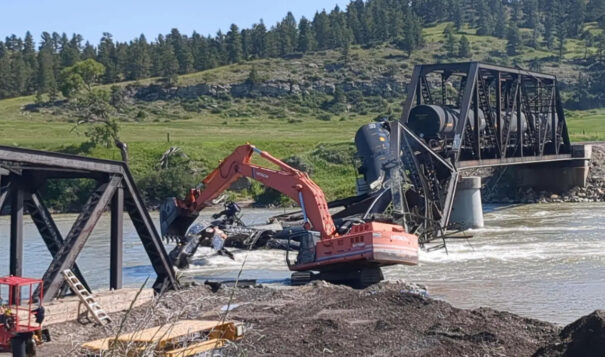News Based on facts, either observed and verified directly by the reporter, or reported and verified from knowledgeable sources.
State advises anglers not to eat fish caught in 48-mile stretch of Yellowstone River
 Heavy equipment operators work at the site of a Montana Rail Link train derailment on June 29, 2023. Credit: Courtesy U.S. Environmental Protection Agency
Heavy equipment operators work at the site of a Montana Rail Link train derailment on June 29, 2023. Credit: Courtesy U.S. Environmental Protection Agency
Announcement comes three months after a Montana Rail Link train derailment led to a 419-000-pound asphalt release.
Nearly three months after a Montana Rail Link train derailed near Reed Point, releasing 419,000 pounds of asphalt into the Yellowstone River, state agencies began advising anglers this week not to eat any fish caught on a nearly 50-mile stretch of the river.
A trio of agencies that work on public health, environmental quality, and fish and wildlife issues adopted the do-not-consume advisory after sampling revealed hydrocarbon concentrations in fish tissue high enough to raise human health concerns.
The specific hydrocarbons that arose in sampling data include naphthalene, acenaphthylene and two forms of methylnaphthalene. All are forms of polycyclic aromatic hydrocarbons, or PAHs, a class of chemicals that occur naturally in coal, crude oil and gasoline. Chronic exposure to PAHs can lead to cancer, according to the Agency for Toxic Substances and Disease Registry. Ingesting high levels of PAHs has also been linked to lung, kidney, skin and gastrointestinal issues in animal studies.
FWP has said it will be difficult to determine the source of the contamination, though the sampling effort is related to the derailment-related release of asphalt, which is made with the heavier constituents of crude oil.
Longnose suckers, shorthead redhorse, rainbow trout, brown trout and mountain trout were included in the sampling, which included fish pulled from sections of the river both upstream and downstream of the bridge that collapsed in late June, sending 10 railcars into the river. The do-not-consume advisory applies to a 48-mile stretch of river between the Indian Fort Fishing Access Site near Reed Point and the Highway 212 bridge in Laurel.
“Multiple species showed levels of various PAHs high enough to warrant an advisory to avoid all consumption,” according to an FWP release about the advisory. The advisory was published about five weeks after DEQ issued a similar advisory for mountain whitefish downstream of the derailment due to sampling that found elevated levels of phenanthrene in that species.
The FWP release also noted that many species of fish, including brown and rainbow trout, migrate seasonally to spawn or in search of cooler water.
“Out of an abundance of precaution and unknown conditions in adjacent sections of the river, those with specific concerns may want to avoid consuming all species of fish from the Yellowstone River at any location until more is known on the severity and prevalence of this contamination,” the Sept. 19 announcement read.
“The source of the PAHs remains unknown. Determining a specific source could be challenging, as PAHs, including those found in these fish, are present in many common materials,” the release continued, adding that some PAHs can occur naturally in the shale rock common in the Yellowstone River Basin. Materials that can include PAHs include oil, gas, plastics and pesticides.
Last month the U.S. Environmental Protection Agency began scaling down efforts to remove asphalt material from the river as crews were finding smaller amounts over time and dropping water levels made access difficult. According to the EPA, at least 19 animals died after becoming befouled with oil released by the wreck. That tally includes eight snakes and 11 birds.
In a press conference held three days after the derailment, Montana Rail Link President Joe Racicot said the company would cover “100%” of the clean-up costs. If previous unintentional petroleum releases into the Yellowstone serve as a guide, Montana Rail Link will be asked to put money into the Natural Resource Damage program, which is nested within the Montana Department of Justice and charged with identifying environmental damage remediation projects.
Earlier this year, funding that ExxonMobil paid into the NRDP following a 2011 oil spill into the Yellowstone was used to purchase two islands on the river near to this summer’s derailment site. The acquisitions were intended to provide wildlife habitat and support the river’s ecological function to address environmental concerns stemming from the pipeline breach.
